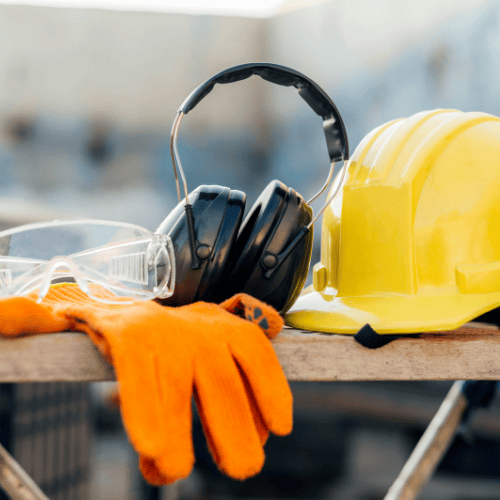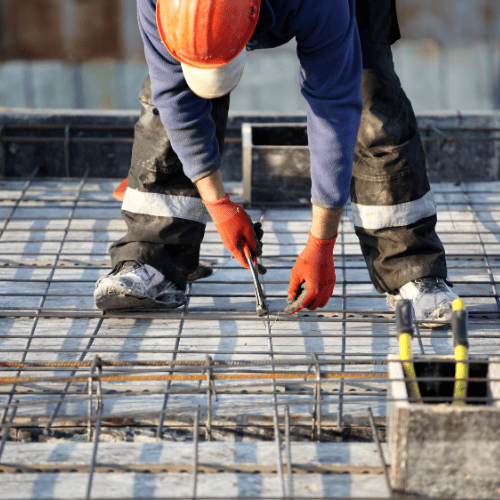
What PPE Is Required on a Construction Site in the UK?
You’ve heard it before.
“It was just a quick job. No time for gear.”
Then something slips…
A scaffold gives way.
A brick falls.
A spark hits exposed skin.
And suddenly, that “quick job” turns into a hospital run, a stop notice, or worse — an HSE investigation.
But here’s the thing: most PPE failures on UK sites aren’t due to bad luck.
They happen because no one was 100% sure what was required, or someone just assumed their standard gloves or boots would “do the job.”
And that’s exactly why I wrote this guide.
Suppose you’re a site manager, contractor, QS, or even just a self-employed tradesperson. In that case, this article will provide you with a no-nonsense checklist of the PPE you legally need on site, how to choose the right gear for each job, and the most cost-effective ways to stay compliant in 2025.
Here’s what you’ll get:
- The exact PPE categories HSE inspects most
- How to match PPE to risk assessments (with real examples)
- What counts as approved PPE (and what doesn’t)
- Internal links to high-quality, UK-certified safety gear — so you’re not left guessing
This isn’t just about ticking boxes.
It’s about building a culture of protection and professionalism that keeps your team working — and keeps inspectors off your back.
Let’s dive in.
The Legal Framework — What UK Law Actually Requires (And What It Doesn’t)

Let’s cut through the noise.
You’ve probably read the PPE regs. Maybe glanced at HSE’s guidance or skimmed the Health and Safety at Work Act.
But the truth is, most people still get PPE wrong. And not because they’re lazy.
Because the rules sound simple, but the real-world implications aren’t.
So, here’s what the law actually says:
Under the Personal Protective Equipment at Work Regulations 2022 (as amended):
- Every employer must provide PPE free of charge
- PPE must be appropriate for the risk (not just “any gloves” — the right gloves)
- It must fit properly, be maintained, and stored correctly
- You can’t ask staff to buy their own gear or bring it from home (yes, even if it’s “better”)
- A full risk assessment must guide what PPE is required
Quick Tip: PPE is your last line of defence. It comes after you’ve tried to eliminate or reduce the hazard.
So What Does That Really Mean On-Site?
Let’s say you’re fitting steel joists.
You need cut-resistant gloves like our GRIPPS FlexiLite MKII Gloves — not basic nitriles.
You need steel-toe boots from the Safety Footwear range — not trainers with toe caps.
You might need eye protection, a helmet, and a high-vis jacket from our PPE & Safety collection.
Now flip the scenario.
You’re sealing a ventilation duct.
The hazard? Chemical inhalation and a tight working space.
You’d need:
- A respirator (not a paper mask)
- Chemical-resistant gloves
- And possibly hearing protection, depending on the surrounding tools
What You Don’t Need (But Many Still Use)
- Generic gloves from Poundland
- Old, worn-out boots “still going strong”
- Shared ear defenders with no sanitation
That’s not compliance. That’s a lawsuit waiting to happen.
Takeaway:
If your PPE doesn’t match the exact risk of the task — and isn’t fit for purpose — you’re not protected, no matter how good it looks.
That’s why we break our PPE & Safety category into clear sections:
So you get the right protection — the first time.
The PPE Checklist – What You Need for Every Construction Role (With Product Links)

You’ve done the risk assessment.
Now comes the hard part: matching the right PPE to the right role.
And let’s be honest — most “PPE guides” online are either too generic (just say “gloves”) or too technical (you need a law degree to decode them).
So here’s our no-fluff checklist — broken down by trade and linked directly to the gear you need.
For General Builders & Bricklayers
Risk Profile: sharp objects, crushing hazards, debris, noise, cement contact
Cut-resistant gloves
Steel toe boots
Safety goggles
High-visibility vests/jackets
Dust masks or respirators
Pro Tip: Don’t skip the dust masks — exposure to silica from bricks is a long-term health risk.
For Scaffolders
Risk Profile: working at height, falling tools, sharp edges, weather exposure
Impact-resistant gloves
[Safety harnesses (site-supplied)]
Hard hats with chin straps
Anti-slip safety boots
Hi-vis workwear
Don’t forget: Scaffold Tags are also part of compliance. If your scaffold isn’t inspected and tagged, PPE won’t save you from an HSE stop notice.
For Electricians
Risk Profile: arc flashes, hand tools, slipping, low-light conditions
[Insulated gloves (or leather over cotton)]
Dielectric safety boots
Eye protection
Hi-vis with flame-retardant properties
PPE must be non-conductive and rated to arc-flash standards. Cheap won’t cut it here.
For Groundworkers
Risk Profile: trench collapse, moving machinery, mud/water hazards
Waterproof boots with ankle support
Hi-vis overalls
Ear defenders
Dust protection & gloves
Groundworkers often face multiple site hazards, so PPE must be multi-functional.
For Plasterers, Decorators & Interior Fitters
Risk Profile: airborne particles, repetitive stress, tool vibration
Latex/nitrile gloves for dexterity
Low-profile dust masks
Safety specs (anti-fog)
[Knee pads/support (especially on tiling jobs)]
They may not be in a “high-risk” zone, but injuries still happen, especially if PPE is overlooked.
Bonus: For Site Visitors & QS Inspections
[Basic PPE Kit]:
- Hi-vis vest
- Hard hat
- Safety boots (shared or low-cost pairs)
Pro tip: Keep a few visitor kits on-site. It’s a small cost that prevents massive liability.
By tailoring your PPE to the role — not just the site — you’ll:
- Improve safety
- Boost team confidence
- Cut down HSE risks
And if you don’t want to dig around for the right items?
Start here: MPS PPE & Safety Store — 100s of certified products, organized by trade and protection level.
What Counts as ‘Compliant PPE’ (And What Will Get You Fined)

Here’s a dirty little secret:
Not all PPE is created equal.
In fact, a surprising amount of gear floating around UK job sites wouldn’t pass an HSE inspection if tested tomorrow.
Why?
Because it’s cheap, poorly certified, or just plain worn out.
The Gold Standard for PPE Compliance in the UK
To pass HSE checks, PPE must meet CE or UKCA certification standards.
That means it’s been independently tested for the hazards it claims to protect against — whether that’s a falling brick, corrosive chemical, or deafening noise.
Your PPE is only compliant if it:
- Has a clear CE/UKCA marking (e.g., EN 388 for gloves, EN ISO 20345 for boots)
- Is in good condition (no cracks, no “just glue it” fixes)
- Matches the hazard (chemical gloves aren’t the same as cut-resistant gloves)
Quick Win: Every product in our PPE & Safety collection is fully certified, meaning you’ll never have to second-guess an HSE audit.
What Will Get You Fined?
- Using non-certified PPE from unknown suppliers (no UKCA marking? Forget it.)
- Failing to replace damaged PPE (those cracked boots or ripped gloves don’t count).
- Not providing the right gear for the risk (e.g., paper masks instead of FFP3 respirators when cutting stone).
- Poor maintenance — PPE needs regular checks, cleaning, and storage to stay compliant.
Real-World Example: The £30,000 Fine
In 2023, a Midlands contractor was fined £30,000 after an employee suffered eye damage. Why?
They were using cheap safety glasses bought online, without proper EN certification.
One £10 mistake cost them thirty grand — and their reputation.
Your No-Brainer Move
Skip the risk. Buy once and buy right:
This isn’t about spending more.
It’s about avoiding the massive cost of a single accident or HSE fine.
How to Choose PPE for Specific Hazards (Noise, Chemicals, Cuts & More)
Here’s the truth: most PPE mistakes happen not because of laziness, but because no one teaches you how to match gear to real-world hazards.
So let’s break it down. No fluff. No theory. Just what protects what, and how to shop smarter.
Hazard: Excessive Noise (Above 80 dB)
Common in: cutting, grinding, demolition, and plant machinery zones
You need:
- Ear defenders or ear plugs rated to EN 352
- SNR rating of 22+ for standard sites, 30+ for high-noise zones
Tip: HSE mandates hearing protection if noise exceeds 85 dB. Don’t just leave it to chance — measure it.
Hazard: Flying Sparks or Hot Work
Common in: grinding, welding, cutting steel
You need:
- Face shields or safety specs with side protection
- Flame-retardant high-vis clothing
- EN 166 compliant eye protection
Paper masks and poly-cotton hi-vis will melt under heat. Flame-retardant gear isn’t optional for hot work.
Hazard: Cuts, Abrasions & Punctures
Common in: handling metal, scaffolding, sharp objects, sheet materials
You need:
- Cut-resistant gloves (EN 388 level C–F)
- Reinforced safety boots with puncture-proof soles
Level C is fine for general handling. But for rebar, glass, or blades? Go Level F or nothing.
Hazard: Dust & Chemical Exposure
Common in: cement mixing, insulation, drainage, spray foam, solvents
You need:
- FFP2 or FFP3 dust masks/respirators
- Nitrile or chemical-resistant gloves
- Eye protection with vented goggles
Don’t use builders’ paper masks for cement or insulation dust. Use FFP3 or risk long-term respiratory damage.
Hazard: Cold, Wet or Outdoor Winter Conditions
Common in: roofing, scaffold, groundwork in winter months
You need:
- Waterproof hi-vis jackets & trousers
- Thermal safety boots
- Insulated gloves that still allow dexterity
PPE only works when it’s worn. If it’s too cold or clunky, workers stop using it. Comfort matters.
Bonus: Manual Handling / Long Hours
Risk: Fatigue, vibration injury, slips from sweat-soaked gloves
You need:
- Anti-vibration gloves
- Supportive footwear with arch & ankle stability
- Breathable materials (no swamp hands)
PPE fatigue is real. If your gear makes tasks harder, productivity drops and accidents increase.
Want to skip the guesswork?
Check out our Trade-Based PPE Kits — sorted by hazard and job role.
PPE Isn’t Just for Compliance — It’s Your Brand
Let’s be honest.
When most people think of PPE, they think checklists, box-ticking, and HSE paperwork.
But on a real job site? PPE does more than protect your team.
It tells your clients who you are.
Think About It…
Your team shows up wearing:
- Faded, mismatched high-vis jackets
- Scuffed boots with gaffer tape
- Dust-covered goggles from 2017
Now imagine your competitor’s crew:
- Clean, branded PPE
- Matching gear
- Certified equipment
Who looks more professional?
Who’s getting the next contract?
Exactly.
PPE Is a Trust Signal
Clients notice the details, especially in construction.
Branded, clean gear says:
“We care about safety, quality, and consistency.”
Scruffy, half-worn PPE says:
“We cut corners.”
“When you invest in PPE, you’re not just protecting people. You’re projecting professionalism.”
It Also Impacts Staff Morale
Ask your crew: Would they rather wear
Quality boots, warm jackets, breathable gloves
or
Cheap, soaked gear that makes the day 10x harder?
Good PPE = happier workers = fewer accidents = better output.
And guess what? They stay longer, too.
And Yes, It Impacts Social Proof
Ever posted your work on LinkedIn?
Sent photos in tenders?
Filmed a case study?
PPE is front and centre in every frame.
If it’s branded, uniform, and clean, it builds credibility instantly.
Here’s What That Looks Like in Practice:
- Equip your team with customised workwear from our PPE & Clothing lines
- Keep high-wear items stocked via our bulk PPE deals
- Build job-role packs (e.g., scaffolders, bricklayers) so everyone has exactly what they need
Recap: PPE Isn’t a Cost — It’s a Brand Investment
- It protects lives
- It secures tenders
- It builds culture
- It elevates your image
Don’t just comply. Lead with it.
FAQs & Pro Tips for Smarter PPE Purchasing
This is the part most construction suppliers miss.
They throw products at you… but never help you choose smartly.
Let’s fix that.
According to UK regulations (PPE at Work Regulations 1992), all employers must provide PPE to workers where there is risk to health or safety. On construction sites, that usually includes:
Safety helmets
Hi-vis jackets
Steel-toe cap boots
Protective gloves
Eye protection
Hearing protection (if noise exceeds 85 dB)
Want to shop compliant gear in one go? Check out our PPE Safety Collection.
This depends on use — but here’s a general rule of thumb:
Boots: Every 6–12 months (sooner if waterlogged or cracked)
Gloves: Weekly for heavy use, monthly for light tasks
Hard hats: Every 2–3 years (check manufacture date inside)
Hi-vis gear: Every 25 washes or once reflectivity fades
Pro Tip: Keep a simple PPE logbook on-site. It’s a game-changer for safety audits and stock rotation.
Absolutely. In fact, you should.
Custom PPE reinforces your brand, boosts team morale, and helps deter theft or mix-ups on site.
Explore our Personalised Workwear Options to get started — including embroidery, heat-seal logos, and custom colour palettes.
What’s the difference between PPE and workwear?
Workwear is your day-to-day gear — think cargo trousers, jackets, or branded polos.
PPE is protective equipment — it’s regulated and designed to prevent injury.
In short:
PPE = safety
Workwear = function and comfort
Explore our full Workwear & Clothing Range for both.
Right here.
At MPS Construction Supplies, we:
Supply trades across the UK
Offer bulk pricing with no minimum order faff
Have free delivery over £149
Carry only quality-tested, construction-grade PPE
Browse the full PPE & Safety Collection
Pro Tips for Smarter PPE Buying
Tip #1: Buy PPE based on job roles, not product categories.
For example:
- Scaffolders need gloves with wet-grip & dexterity
- Joiners need dust protection & anti-fog goggles
- Roofers need anti-slip footwear & head protection
Tip #2: Choose certified gear
Look for markings like EN ISO 20345 for boots, EN 166 for eyewear, and CE labels across all items.
Tip #3: Bulk buy gloves & consumables
These run out fast. Keep your top picks in stock — like our Nitrile-Coated Grip Gloves from just £0.99.
Tip #4: Build a PPE box per van or crew
Makes loading out easy. Add everything from line marker spray to ear protection.
Final Words: The PPE You Buy Today Protects Your Business Tomorrow
You’re not just buying kit. You’re buying confidence, compliance, and credibility — job after job.
So whether you’re a solo brickie or managing five crews across London, PPE isn’t where you save pennies — it’s where you secure contracts.
Now go gear up your team like the pro you are.
